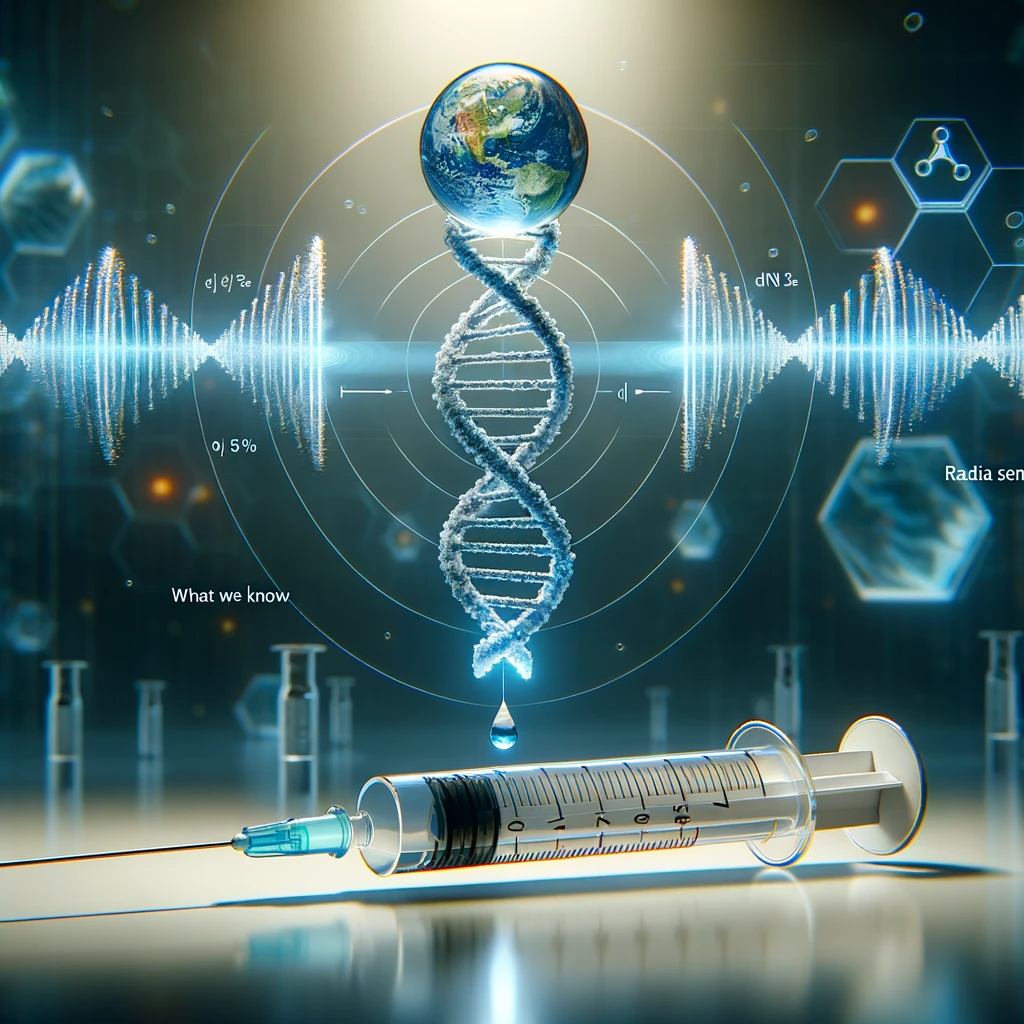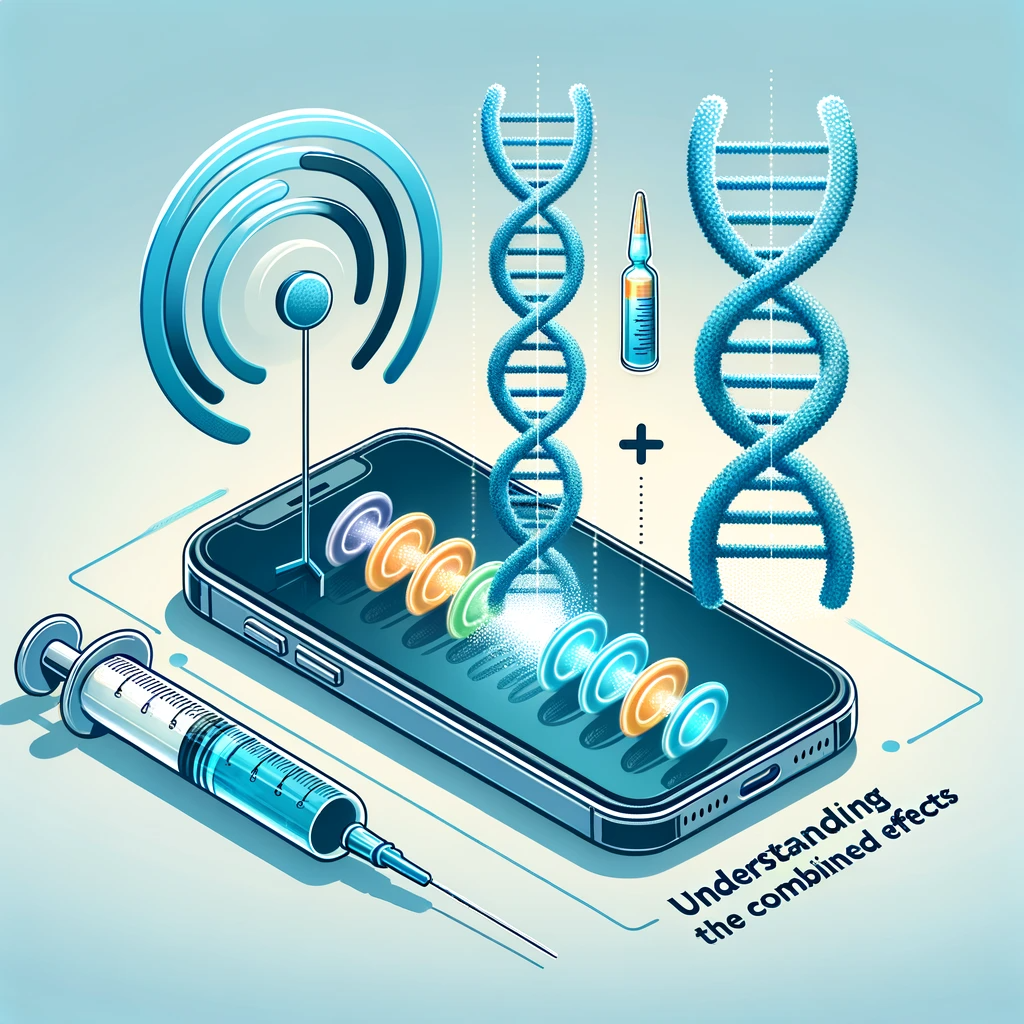Combining the potential effects of overproduction of Reactive Oxygen Species (ROS) due to cell phone microwave exposure and the residual injected DNA from vaccines that can induce type I interferon responses:
1. Overproduction of ROS from Cell Phone Microwave Exposure:
- What is ROS? ROS are chemically reactive molecules containing oxygen. They play several roles in cellular processes, but in excessive amounts, they can damage cells.
- Cell Phone Microwave Exposure: Non-ionizing radiation from cell phones can lead to the overproduction of ROS in cells.
- Potential Effects:
- DNA Damage: Excessive ROS can lead to oxidative stress, which can damage DNA. DNA damage is a precursor to several diseases, including cancer.
- Cellular Dysfunction: Oxidative stress can impair cellular functions, leading to a range of health issues beyond DNA damage, such as inflammation and premature aging.
2. Residual Injected DNA from Vaccines:
- What is it? As mentioned in the study referenced here, certain vaccines might have DNA contamination.
- Potential Effects:
- Type I Interferon Responses: The body can recognize this foreign DNA, leading to a type I interferon response. Type I interferons are proteins produced by the body in response to viral infections. They play a crucial role in regulating the immune response.
- Potential for DNA Integration: While the risk is generally considered low, there’s the potential for foreign DNA to integrate into the host genome, which could lead to unpredictable genetic changes.
Combining the Two Risk Factors:
3. Combined Stress on Cells:
- Dual Assault: If cells are simultaneously exposed to elevated ROS levels (from microwave radiation) and residual injected DNA (from vaccines), they face a dual assault. The oxidative stress from ROS could weaken cellular mechanisms, making the cell more vulnerable to any potential adverse effects of foreign DNA.
- Amplified DNA Damage: Elevated ROS can cause DNA damage, and the presence of foreign DNA might further strain the cellular machinery responsible for repairing DNA. This could increase the likelihood of mutations or other genetic anomalies.
4. Combined Immune Response:
- Inflammation: Both oxidative stress (from excessive ROS) and type I interferon responses can lead to inflammation. Chronic inflammation is linked to several health issues, including heart disease, cancer, and neurodegenerative diseases.
- Potential Autoimmunity: Chronic activation of the immune system, such as through sustained type I interferon responses, can sometimes lead to the immune system mistakenly targeting the body’s own cells, leading to autoimmune conditions.
While each of these factors individually presents potential risks, their combination could synergistically exacerbate the effects on cellular health and immune responses. However, it’s essential to note that these are potential risks and the actual outcome in a real-world scenario would depend on various factors, including the intensity and duration of exposure, individual genetic factors, and overall health. More research would be needed to ascertain the combined effects definitively.
We need research! Now!
With the recent news that Health Canada found an SV40 DNA sequence in the Pfizer mRNA COVID-19 vaccine, which has historical associations with polio vaccines and thus raises health concerns and other studies found dsDNA contamination concerns. This, combined with the potential risks associated with cell phone microwave exposure, warrants a deeper investigation into their combined effects, especially in the context of the so-called ‘turbo cancers’ and the explosion of autoimmune disorders.
Individual Risks:
RF Exposure: Chronic RF exposure has been associated with increased ROS production, potentially leading to oxidative stress and subsequent DNA damage.
dsDNA Contamination and SV40 DNA Sequence in Early Covid Vaccines: The DNA contamination sequence’s presence, was previously undisclosed by Pfizer. While some scientists suggest potential risks, others believe the specific contamination in the vaccine might not pose a significant health risk by itself.
Theoretical Combined Effects:
Amplified Cellular Stress: If cells are exposed to both increased ROS (from RF exposure) and the DNA contamination sequence, there could be an amplified cellular stress response. This might weaken cellular repair mechanisms, potentially leading to mutations or other genetic anomalies.
Potential DNA Integration: Given the concerns raised about the DNA contamination sequence’s potential to integrate with human DNA, the additional stress from RF exposure might elevate this risk, even if marginally.
Proposed Experiment:
Objective: To study the combined effects of RF exposure and the DNA contamination present in the mRNA COVID-19 vaccine.
Methodology:
Sample Selection: Lab rats, due to their shorter lifespan, will be used. They’ll be divided into four groups:
Control group
RF exposure group
Vaccine (with SV40 DNA sequence/dsDNA Contamination) group
Combined RF exposure and vaccine group
RF Exposure: The RF and combined groups will be exposed to controlled RF radiation, simulating chronic cell phone usage.
Vaccine Administration: The vaccine and combined groups will receive a dose containing the SV40 DNA sequence/dsDNA Contamination.
Observation Period: Monitor for a significant portion of their lifespan, checking for tumors or health abnormalities.
Histopathological Analysis: Post-observation, conduct an analysis to identify cellular abnormalities or tumors.
Expected Outcomes: The combined group might show a higher incidence of cellular abnormalities or tumors, suggesting a possible synergistic effect of RF exposure and DNA contamination that was found in the early mRNA COVID-19 vaccines that much of the world was sold as safe and effective.
Conclusion: Given the recent revelations and the potential risks associated with both RF exposure and the DNA contamination found, understanding their combined effects is paramount. This theoretical exploration aims to shed light on the potential implications, emphasizing the need for further empirical research.
Note: This is a theoretical exploration based on the provided premise and the recent findings, and should be considered a hypothesis until further research provides concrete evidence. However, to overlook the combined health effects of the vaccines being administered to the masses, the contaminates found in them, the spike protein, and cellphone radiation together is a horrible mistake by the scientific community
The quality and safety of certain mRNA vaccines by examining the DNA contamination levels in them.
- High DNA Contamination Levels: There are significantly higher levels of DNA contamination in the vaccines than recommended by the European Medicines Agency (EMA).
- Assessment Methods: Various methods were used to assess DNA contamination, including Qubit™ 3, Agilent Tape Station™, qPCR, and RT-qPCR. While these methods differ in their results, all indicate that DNA contamination is considerably higher than recommended.
- qPCR Considerations: The qPCR method seems to undercount DNA contamination, especially when the DNA is fragmented or when competing RNA sequences are present.
- Nature of DNA Contaminants: The study raises concerns about the type of DNA contaminants. DNA sequences with mammalian promoters or antibiotic resistance genes are more concerning than random E.coli genomic DNA.
- Integration into Human Genome: There’s debate about whether SARs-CoV-2 and mRNA vaccines can integrate into the human genome. This study points out that the presence of dsDNA contamination and specific sequences (like the SV40 nuclear localization signal) in the vaccine could increase the odds of genome integration.
- Vaccine Vials’ Provenance: A limitation of this study is that the source of the vaccine vials is unknown. They were sent anonymously and might have been stored improperly, which could affect the DNA to RNA ratios.
Twitter Thread on Combined Effects of ROS and Residual DNA:
Tweet 1: 🔬 Exploring the combined effects of ROS (Reactive Oxygen Species) and residual DNA in vaccines. A thread👇
Tweet 2: 📌 Cells exposed to high ROS levels (often from sources like cell phone radiation) and foreign DNA (from some vaccines) might be at heightened risk of damage.
Tweet 3: 🚨 This dual exposure could make our immune system react more strongly. Result? Potential inflammation and, in some cases, the triggering of autoimmune conditions.
Tweet 4: 🤔 There’s an ongoing debate: Can SARs-CoV-2 & mRNA vaccines integrate into our genome? The presence of dsDNA contamination and specific sequences in vaccines might increase this risk.
Tweet 5: ⚠️ The combo of vaccines, their contaminants, the spike protein, & cell phone radiation is a critical area of study. We can’t afford to overlook these intertwined factors.
Tweet 6: 🔍 Ignoring these could have serious repercussions. It’s high time the scientific community dives deeper into empirical research on these combined effects.
Tweet 7: 🙏 Prioritizing research in this domain isn’t just about scientific curiosity; it’s about safeguarding global health and understanding potential long-term implications. #ROS #VaccineResearch #CellPhoneRadiation
Twitter Thread on SV40 Enhancer in Vaccines:
Tweet 1: 🔍 Dr. Patrick Provost from Laval University speaks on SV40 enhancer sequences in mRNA vaccines. A deep dive into potential concerns.👇
Tweet 2: 🧬 The SV40 enhancer sequence, used in vaccine amplification, has the potential to integrate into a cell’s DNA genome. Dr. Provost warns, “All it takes is a single integration at the wrong place in a single cell to initiate a cancerous process.”
Tweet 3: ⚠️ If the plasmid DNA wasn’t degraded enough by DNases, the SV40 enhancer could still be present. Given that the SV40 sequence is 72bp and degraded DNA fragments found were about 100bp, the presence of the SV40 sequence in vaccines is deemed “not negligible”.
Tweet 4: 🧫 An alarming point: The DNA fragments in the vaccines might be encapsulated in lipid nanoparticles. This could potentially boost their delivery into human cells, making current DNA contamination thresholds irrelevant.
Tweet 5: 📅 Back in April 2023, microbiologist Mr. McKernan discovered the SV40 enhancer in Pfizer vaccines. He argued its inclusion was “all risk, no reward.” Especially since Pfizer’s vaccines already contain an AmpR promoter, making SV40 redundant.
Tweet 6: ⚠️ While the full 5kb SV40 virus was found in polio vaccines, even just the presence of SV40 promoters is concerning due to potential integration near oncogenes, which could cause cancer.
Tweet 7: 🔬 Dr. Angus Dalgleish observed a higher incidence of aggressive cancers post COVID-19 vaccination. While he notes potential “DNA plasmid & SV40 integration in promoting cancer development,” these concerns remain hypothetical.
Tweet 8: ✋ Health Canada, however, stated that current data doesn’t support the occurrence of new aggressive “turbo cancers” after vaccination.
Tweet 9: 🔍 Many experts voice concerns about the potential risks, emphasizing that the scientific establishment must rigorously investigate and transparently report findings. “People have a right to have their concerns taken seriously,” Mr. Buckhaults remarked.
Tweet 10: In conclusion, while concerns are raised, they remain hypothetical for now. Yet, the scientific community must remain vigilant and prioritize thorough research. Our global health depends on it. 🌍🩺









